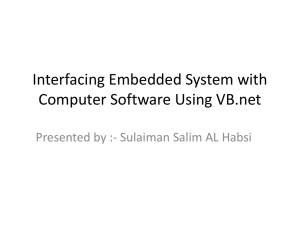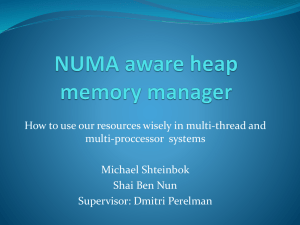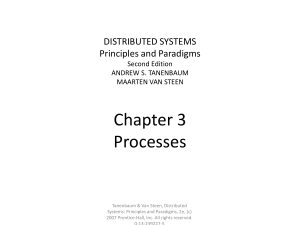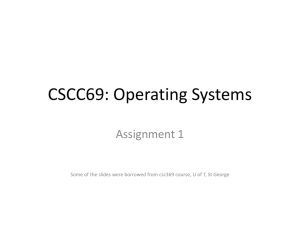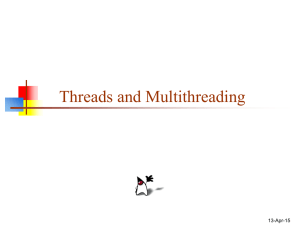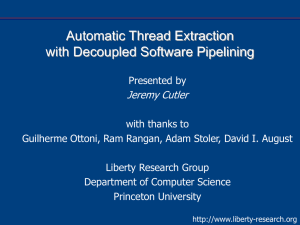The data structure
advertisement
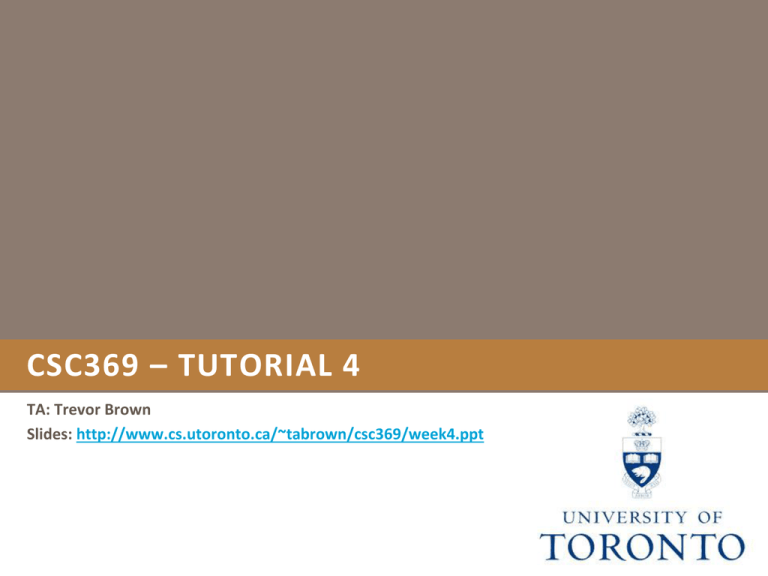
CSC369 – TUTORIAL 4 TA: Trevor Brown Slides: http://www.cs.utoronto.ca/~tabrown/csc369/week4.ppt UNIX-LIKE SIGNALS In Unix, the signal number represents a bit position in a 32bit flag in the thread struct Allows a thread to be sent multiple types of signals Positives? minimal memory space, no dynamic memory allocation needed just setting a bit is fast… Negatives? Signals can be lost. How? … if two of the same type are sent before the first is handled. UNIX-LIKE SIGNALS The data structure Create signal queue for each thread linked list of structs containing a field that identifies the signal type Get reliable signal delivery, but… Downsides: more memory more time to allocate a struct and queue it up What should you do? You are free to design your own mechanism, but For the signals we are supporting, losing a repeat is not a big deal. Most people should prefer the simpler design. UNIX-LIKE SIGNALS An alternative design? How do we send signals? Using the sys_kill() system call The signaler (the thread that call sys_kill()): Set a bit in the target thread Error check and return What kinds of things do we do to error check? Returning: copyin/out The signaled thread: Checks its signal flag before returning to user space Handles any signals that are marked UNIX-LIKE SIGNALS The algorithm – how does it work? SIGKILL Order a thread to roll over and die SIGSTOP Order a thread to go to sleep Sleeping beauty style: must wait for prince SIGCONT to wake SIGCONT Wake up a thread put to sleep with SIGSTOP UNIX-LIKE SIGNALS Some examples of signals Funny cases are design decisions They should appear in your design document! What else should appear in your design doc.? Any time you choose among several algorithms, why? How does a thread wait for SIGCONT after getting SIGSTOP? One way: use a condition variable Recall, a condition variable supports operations: wait() (suspend the invoking process and release the lock) signal() (resume exactly one suspended process) broadcast() (resumes all suspended processes) We said a signaled thread checked and handles signals before returning to user space… What if a thread receives a signal in kernel space? Should a thread immediately die if it receives SIGKILL? UNIX-LIKE SIGNALS Funny cases and design decisions ASSIGNMENT 2 In a nut-shell: Check out the new code (“…/a2” instead of “…/a1”) Implementing parts of the PID system noting that pid.c is a monitor which protects access to the PID array! Implementing missing synchronization functions thread_join thread_detach thread_exit thread_fork These must work together! Implementing missing system calls getpid waitpid kill ASSIGNMENT 2 What are you doing in A2? ASSIGNMENT 2 Old slides 1/5 ASSIGNMENT 2 Old slides 2/5 ASSIGNMENT 2 Old slides 3/5 ASSIGNMENT 2 Old slides 4/5 ASSIGNMENT 2 Old slides 5/5 Look at the new code in kern/thread Search functionality in an IDE (e.g., NetBeans) makes browsing code (and finding functionality) much easier Be very thorough. If one person implements, the other should code-read and test. Read the man pages so you understand the parameters received and errors returned. Reminders: pid.c serves as a monitor to an important data structure getpid and waitpid are user level tools thread_join and thread_detach are kernel level tools http://www.cdf.toronto.edu/~csc369h/fall/assignments/a2/a2.shtml ASSIGNMENT 2 Some tips for A2


